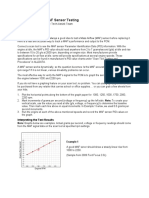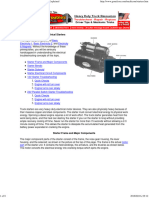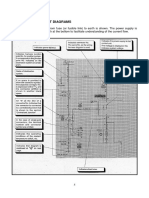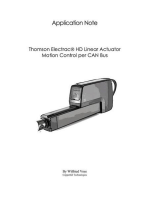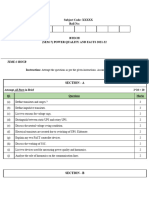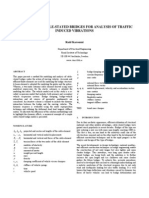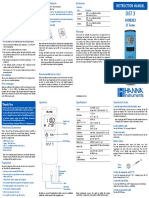27 Appendix D Technical Reference & Specifications
Uploaded by
papipapii27 Appendix D Technical Reference & Specifications
Uploaded by
papipapiiAppendix D
Technical Reference & Specifications
Diagnostic Tester
Fig. D-1
TL874fD01
Engine Control Systems II - Course 874
D-1
Appendix D
DIAGNOSTIC REFERENCE INFORMATION
Vane Air Flow Meter (Vs)
Circuit
Description
The vane air flow meter is located in the intake air duct between the air
cleaner housing and the engine throttle body. It provides the ECM
information on the amount of load placed on the engine by directly
measuring intake air volume.
During engine operation, intake air flow reacts against the meters
measuring plate, which causes it to deflect in proportion to the volume
of air flow. This movement is transferred through a shaft to a movable
arm on the meters potentiometer (variable resistor). The Vs signal to
ECM varies according to the potentiometers position.
The vane air flow meter also houses the intake air temperature sensor
and a fuel pump switch. The fuel pump switch is used to maintain fuel
pump operation after start-up (when sufficient air flow exists to open
the measuring plate).
Vane
Air Flow Meter
Vc
E2
5.0
Voltage (V)
The Vs signal represents
the amount of load
placed on the engine.
The potentiometer
provides a variable
voltage signal back to
the Vs terminal of the
ECM.
As shown in the graph, Vs
signal voltage decreases with
higher air flow (larger
measuring plate opening). The
Vc - E2 line represents the 5V
reference source.
Vs
E2
NOTE: The 22R-E and 4A-GE
engines use an air flow meter
with opposite voltage logic.
0
Measuring Plate Opening
ECM
Air Flow Meter
Vc
r2
r1
Vc
5V Vc
R1
Vs
Vs
Pump Switch
E2
E2
E1
E1
Microcomputer
R2
Fig. D-2
TL874fD02
D-2
TOYOTA Technical Training
Technical Reference & Specifications
Troubleshooting
Hints
The air flow meter is provided a regulated 5V reference at Vc terminal.
As indicated in the graph, the voltage reading at Vs terminal with
Ignition ON, Engine OFF should be between 3.7V - 4.3V.
Once the engine is started, Vs signal voltage should decrease to
indicate initial measuring plate opening.
The r2 resistor (which is connected in parallel to the r1) allows the
meter to continue to provide a Vs signal in the event an open occurs
in the main potentiometer (r1).
The R1 and R2 resistors provide the ECM with self-diagnostic
capabilities and also provides a fail-safe voltage in the event of an
open circuit.
OBD Diagnostic
Trouble Codes
OBD II
Diagnostic
Trouble Codes
Typical Serial
Data
DTC #
Effected Circuit
Diagnostic Trouble Code Detection Condition
31
Vs Circuit
Open or Short (Vc) in Air Flow Meter Circuit for Specified Time
32
Vs Circuit
Open or Short (Vc Vs) in Air Flow Meter Circuit
for Specified Time
DTC #
Effected Circuit
P0100
Air Flow Meter
Circuit
Air Flow Meter Circuit Malfunction
P0101
Air Flow Meter
Circuit
Air Flow Meter Circuit Range/Performance Problem
Diagnostic Trouble Code Detection Condition
Data Source
Name
Units
Warm Idle
OBD
Vs
volts
2.5V 0.5V1
OBD II
____________
____________
____________
V-BoB
Vs
volts
2.5V 0.5V1
1. 3VZ-FE = 2.8V 0.6V
Engine Control Systems II - Course 874
D-3
Appendix D
DIAGNOSTIC REFERENCE INFORMATION
Karman Vortex Air Flow Meter (Ks)
Circuit
Description
Like the vane air flow meter, the Karman Vortex Air Flow Meter is
located between the air cleaner housing and the engine's throttle body.
It also provides the ECM with the same type of information; an intake
air volume signal that is used to determine the amount of load placed
on the engine.
The operation of the Karman Vortex Air Flow Meter differs from that of
the vane type. During engine operation, a swirling effect is created in
the intake air stream when it reacts against the meter's vortex
generator. A sample of this pulsating air is then applied to a movable
metal foil mirror, which causes it to flutter. The oscillating mirror causes
light from the photo coupler's LED to be alternately applied and diverted
from a phototransistor.
As a result, the phototransistor rapidly switches the 5V Ks signal to the
ECM. As shown in the diagram, the frequency of the Ks signal increases
proportionally with intake air flow.
Karman Vortex
Air Flow Meter
Inside the Karman
Vortex air flow meter,
intake airflow oscillates
a movable mirror which
turns a light sensitive
photo transistor
on and off.
High
Voltage
Signal (Ks)
Volts
Low
Time
Low
High
Air Flow Meter
As shown in the
diagram, the Ks
5V square wave
signal increases in
frequency with
higher intake air
volume.
ECU
5V Vc
Vc
Vc
Ks
Ks
E2
E2
Fig. D-3
TL874fD03
D-4
TOYOTA Technical Training
Technical Reference & Specifications
Troubleshooting
Hints
Remember a 5V signal operating at a 50% duty cycle will read
approximately 2.5V. Since Ks operates at approximately 50% duty
cycle during engine operation, Ks signal voltage will provide little
useful information during diagnosis.
Ks signal frequency changes dramatically with engine load changes.
For this reason, observing Ks frequency changes would provide the
most useful diagnostic information. Accurate Ks signal inspection
requires using an oscilloscope or high quality digital multimeter with
frequency capabilities (non-OBD vehicles).
OBD Diagnostic
Trouble Codes
OBD II
Diagnostic
Trouble Codes
Typical Serial
Data
DTC #
Effected Circuit
Diagnostic Trouble Code Detection Condition
31
Ks Circuit
DTC #
Effected Circuit
P0100
Air Flow Meter
Circuit
Air Flow Meter Circuit Malfunction
P0101
Air Flow Meter
Circuit
Air Flow Meter Circuit Range/Performance Problem
Open or Short in Air Flow Meter Circuit for Specified Time
Diagnostic Trouble Code Detection Condition
Data Source
Name
Units
Warm Idle
OBD
Ks
ms
40ms 15ms
OBD II
____________
____________
____________
V-BoB
Ks
ms
40ms 15ms
Engine Control Systems II - Course 874
D-5
Appendix D
DIAGNOSTIC REFERENCE INFORMATION
Mass (Hot-Wire) Air Flow Meter (VG)
Circuit
Description
The Mass Air Flow Meter provides some distinct advantages over the
"volume" type air flow meters. Since this type of air flow meter directly
measures air mass (and not just volume), any factor affecting the
density of the intake air will influence the output signal. These factors
include air temperature, humidity and altitude.
This type of Mass Air Flow Meter uses a "hot wire" and thermistor
placed in a path of sample intake air flow. It operates on the theory
that the hot wire is cooled by incoming air mass, in proportion to air
flow. The circuit is the hot wire and incoming air flow by regulating bot
wire current flow with the power transistor.
The circuit operates as a "feedback" system to equalize the electrical
potential between points A and B. If a difference exists, the operational
amplifier varies the output of the power transistor to rebalance the
circuit. In this way, a variable DC voltage signal is output to the VG
terminal of the ECM.
Mass
Air Flow Meter
As shown in the graph, VG
signal voltage increases with
higher intake air mass. The
ECM interprets higher VG
voltage as increased load
placed on the engine,
increasing injection quality
and retarding spark.
The Mass Air Flow Meter
signal takes into account
any factor affecting air
mass or density, such as:
air temperature, humidity
and altitude.
Incoming air cools the
hot wire, lowering its
resistance value and
increasing output voltage
at point B (VG signal).
+B
Power Transistor
Thermistor
Platinum Hot Wire
A
Output Voltage
Fig. D-4
TL874fD04
D-6
TOYOTA Technical Training
Technical Reference & Specifications
Troubleshooting
Hints
Unlike volume airflow meters, this hot-wire mass air flow meter uses
battery voltage (+B) rather than the 5V-reference voltage source VC.
A VG signal check may be performed with Ignition ON, Engine OFF:
While blowing towards the hot wire, observe the VG signal changes.
On OBD II vehicles the following diagnostic rule applies:
OBD Diagnostic
Trouble Codes
OBD II
Diagnostic
Trouble Codes
Typical Serial
Data
a MAF reading of 0 gm/sec would indicate an open in +B circuit or
open or short in VG circuit.
a MAF reading of 271 gm/sec or more would indicate an open in
VG- (ground) circuit.
DTC #
Effected Circuit
Diagnostic Trouble Code Detection Condition
31
VG Circuit
DTC #
Effected Circuit
P0100
Air Flow Meter
Circuit
Air Flow Meter Circuit Malfunction
P0101
Air Flow Meter
Circuit
Air Flow Meter Circuit Range/Performance Problem
Open or Short in Air Flow Meter Circuit for Specified Time
Diagnostic Trouble Code Detection Condition
Data Source
Name
Units
Warm Idle
OBD
VG
gm/sec
3.8 1.2 gm/sec
OBD II
VG
gm/sec
3.8 1.2 gm/sec
V-BoB
VG
volts
0.7V to 1.7V
Engine Control Systems II - Course 874
D-7
Appendix D
DIAGNOSTIC REFERENCE INFORMATION
Engine Coolant Temperature Sensor Circuit (ECT)
Circuit
Description
The Engine Coolant Temperature sensor circuit is used to monitor
engine temperature, supplying the ECM with important information to
determine fuel enrichment, spark angle, idle speed control, and
emissions control system status.
The sensor, which is typically located near the thermostat housing, is a
negative temperature coefficient (NTC) thermistor. Sensor resistance
falls as the temperature rises. The sensor is connected in series with a
pull-up resistor in the ECM, which acts as a voltage divider. As
resistance of the sensor falls with increasing coolant temperatures, the
voltage drop across the sensor also falls. The sensor circuit, therefore,
generates an analog voltage signal, which varies inversely with the
temperature of the engine coolant.
Pull-up resistor Rl can have a resistance value of either 2.7K or 5K
depending on engine application The chart below shows the normal
signal voltage characteristics for both resistance values.
Engine Coolant
Temperature
Sensor Circuit
The Engine Coolant
Temperature sensor
monitors engine
temperature by use of a
voltage divider circuit.
The pull-up resistor in
the ECM is fixed value
while the resistance of
the sensor thermistor
varies inversely with
coolant temperature.
Fig. D-5
TL874fD05
D-8
TOYOTA Technical Training
Technical Reference & Specifications
Troubleshooting
Hints
The Engine Coolant Temperature sensor signal is represented on a
Diagnostic Tester in F or C temperature units. When using the
Vehicle Break-out Box (V-BoB), coolant temperature can be displayed
either in temperature units or as a voltage (by toggling the F7 key.)
Engine Coolant Temperature sensor information is replaced by a
failsafe value whenever the ECM detects a fault in the circuit. When
troubleshooting with a Diagnostic Tester, using the OBD data stream,
failsafe value is displayed rather than actual value.
To quick check circuit integrity using the OBD data stream, install
a 1.2KW resistor across the ECT sensor harness terminals. If
temperature displayed on Diagnostic Tester reads between
approximately 35C (95F) to 43C (110F), the electrical circuit is good.
To quick check circuit integrity using OBD II or V-BoB data stream:
OBD Diagnostic
Trouble Codes
Disconnect sensor harness: displayed temperature should go to
approximately -40C (-40F) (5V)
Short sensor harness THW to E2: displayed temperature should go
to approximately 120C (248F) (0V)
DTC #
22
OBD II
Diagnostic
Trouble Codes
Typical Serial
Data
DTC #
Effected Circuit
Diagnostic Trouble Code Detection Condition
Engine Coolant
Detects an open or short circuit in the Engine Coolant
Temperature
Temperature circuit for more than a specified amount of time.
Sensor Circuit
Effected Circuit
Diagnostic Trouble Code Detection Condition
P0115
Engine Coolant
Detects an open or short circuit in the Engine Coolant
Temp. Circuit
Temperature circuit for more than a specified amount of time.
Malfuntion
P0116
Engine Coolant Detects sensor range or performance problem by monitoring the
Temp. Circuit time it takes for sensor signal to reach and exceed a specified
Range Problem minimum temperature.
Data
Source
Name
Units
Warm Idle
THW
shorted to
E2
Circuit
Open
OBD
ECT
F or C
85C to 104C
(185F) to (220F)
80C
(176F)
80C
(176F)
F or C
85C to 104C
(185F) to (220F)
120C
(248F)
-40C
(-40F)
F or C
or volts
85C to 104C
(185F) to (220F)
0.1V to 0.5V
120C
(248F) or
0V
-40C
(-40F) or
5V
COOLANT
OBD II
V-BoB
TEMP.
THW
Engine Control Systems II - Course 874
D-9
Appendix D
DIAGNOSTIC REFERENCE INFORMATION
Throttle Position (TP) and Closed Throttle Position (CTP)
Sensor Circuit
Circuit
Description
The Throttle Position sensor is attached to the throttle body. It monitors
throttle valve opening angle and closed throttle status.
The sensor generates an analog voltage signal, which varies in
proportion to throttle opening, from low to high as the throttle is
opened. The TP sensor also includes a digital idle contact switch, which
is closed at idle and opens as the throttle is tipped open. Signal
characteristics are represented by the graph shown below.
Information from the this sensor is used by the ECM to make
judgments about power enrichment, deceleration fuel cut, idle air
control, spark advance angle corrections, and the status of emissions
control sub-systems.
Throttle
and Closed
Throttle Position
Sensor Circuit
(V)
TP signal can be easily
measured with a voltmeter or a
scan tool. The voltage signal
moves from low to high as the
throttle opens. The CTP signal
is low at idle and goes high
when the throttle is opened.
5-12
5
4
Throttle position sensor
uses a potentiometer and
simple switch contact to
monitor throttle angle
and closed throttle
status.
ut
utp
O
VTA
3
2
1
0
Fully Open
Idling
Closed
Throttle Valve
Open
Scan data is displayed in
degrees throttle valve angle or
in percentage of opening.
ECM
Throttle Position Sensor
5V
VC
12V
VTA
IDL
E2
Fig. D-6
TL874fD06
D-10
TOYOTA Technical Training
Technical Reference & Specifications
Troubleshooting
Hints
Throttle Position sensor signal is represented differently on OBD and
OBD II data streams. OBD displays opening angle in degrees ranging
from 0 to 75. OBD II displays throttle opening as a percentage of
wide-open throttle, ranging from about 5% to 80%.
On V-BoB, TP sensor signal is represented in degrees opening angle or
as an analog voltage (by toggling the F7 key).
Throttle angle scan data defaults to a failsafe value when a fault is
detected in the TP sensor circuit. Depending on application, throttle
angle will go to either 30 or 0 when a fault is detected, as long as the
CTP switch remains open. When the CTP switch closes, the signal
defaults to 0 and remains there. If the fault is intermittent, the TP
signal will return to normal only after the vehicle speed sensor
indicates 0 mph.
To quick check the circuit using a Diagnostic Tester, observe serial
data while depressing the accelerator pedal to wide open. Signal
should increase to near maximum. For intermittent problems, use
V-BoB data or oscilloscope.
Code 51 for CTP switch contact will only set when an open circuit
fault is detected. Shorted CTP will cause fuel cut to occur above fuel
cut rpm threshold.
OBD Diagnostic
Trouble Codes
OBD II
Diagnostic
Trouble Codes
Typical Serial
Data
DTC #
Effected Circuit
Diagnostic Trouble Code Detection Condition
41
Open or short detected in the VTA line to ECM for more than a
Throttle Position
specified amount of time. (NOTE: disconnected sensor will not
Sensor Circuit
set code 41)
51
Switch Condition Open detected in Closed Throttle Position switch circuit (NOTE: Only displays
when TE1 is grounded [code display mode]. Will also display if PNP signal
Signal
indicates trans in gear or if A/C input is ON. Code does not store in memory.
DTC #
Effected Circuit
Diagnostic Trouble Code Detection Condition
P0100
Open detected in circuit (VTA lower than specified with CTP
Throttle Position
switch open)
Sensor Circuit
Short detected in circuit (VTA higher than specified voltage)
P0121
Throttle Position
Sensor Signal With CTP switch closed, VTA is greater than specified voltage
Range Problem
Data Source
Name
Units
Key ON/Wide
Open Throttle
Warm Idle
OBD
Throttle
Open
> 70
OBD II
Throttle POS
% Open
65% to 75%
7% to 11%
V-BoB
VTA
Open or volts
>70 or 3.5Vto 4.8V 0 or 0.2V to 0.8V
Engine Control Systems II - Course 874
D-11
Appendix D
DIAGNOSTIC REFERENCE INFORMATION
Power Distribution Circuit
Circuit
Description
The power distribution circuit consists of a Main Relay, the ignition
switch, the ECM, and related wiring. There are basically two different
types of power distribution circuits, ECM controlled and ignition switch
controlled.
ECM controlled power distribution is used on applications with a Step
Motor IAC system. All other applications use the ignition switch
controlled system. In both cases, the power distribution electrical wiring
carries electrical current from the battery, through the Main Relay,
through the ECM, and back to the battery through the E1 ground.
WITH STEP TYPE IACV
Power
Distribution
Circuit
With Step Motor IACV
When the ignition switch
is in the Start or Run
position, current flows to
the ECM IGSW terminal,
signaling the ECM to
turn on the MREL circuit.
The ECM sends current
through the MREL circuit
and Main Relay pull-in
winding, to ground. This
closes the power contact,
causing current to flow to
the ECM +B terminals.
WITHOUT STEP TYPE IACV
Without Step Motor IACV
When the Ignition switch
is in the Start or Run
position, current flows
through the main relay
pull-in winding, to
ground, causing the
power contact to close.
This causes current to
flow through the power
contact to the ECM +B
terminals.
Fig. D-7
TL874fD07
D-12
TOYOTA Technical Training
Technical Reference & Specifications
DIAGNOSTIC REFERENCE INFORMATION
Fuel Pump Control Circuit
Circuit
Description
Fuel pump control methods differ between models that use a vane air
flow meter and those that do not. On models using a vane air flow meter,
a fuel pump switch located inside the meter is used to maintain fuel
pump operation once the engine has started. During cranking, the STA
signal commands the circuit opening relay to provide power to the fuel
pump. After start-up, intake air flow opens the air flow meter's measuring
plate closing the fuel pump switch. As a result, the circuit opening relay
will maintain fuel pump operation after the engine has started.
On other systems, the circuit opening relay still operates the fuel pump
from the STA command during cranking; however after the engine has
started, the ECM must switch on the Fc circuit to continue pump
operation. On this type of system, the ECM must continue to see an
engine speed signal (NE) in order to continue operating the fuel pump
after the engine has started.
Fuel Pump
Control Circuit
During cranking, the
circuit opening relay
powers the fuel pump
based on the STA signal
command.
After start-up fuel control
differs in that systems
using a vane air flow
meter use a fuel pump
switch to maintain pump
operation. All others use
ECM control of the Fc
signal to maintain fuel
pump operation.
Terminal
+B
Fc
Fp
Cranking
12V
12V
Engine
Running
12V
< 1V
12V
Condition
As shown in the chart, Fc
control voltage is pulled low
(grounded) by either the fuel
pump switch (when intake
air flow is sufficient) or the
ECM (when Ne signal is
above a specified rpm) to
keep the fuel pump
operating after start-up.
Fig. D-8
TL874fD08
Engine Control Systems II - Course 874
D-13
Appendix D
DIAGNOSTIC REFERENCE INFORMATION
Injector Drive Circuit
Circuit
Description
The design of the injector drive circuit determines when each injector
delivers fuel in relation to the operating cycle of the engine. Depending
on the engine application, the drive circuit design may be either a
Simultaneous, Grouped, or Sequential type. In all designs, voltage is
supplied to the injectors from the ignition switch or EFI main relay and
the ECM controls injector operation by turning on the driver transistor
grounding the injector circuit.
On Simultaneous type drive circuits, all injectors are pulsed at the same
time by a common driver circuit. Injection occurs once per engine
revolution, just prior to TDC No. 1 cylinder. Twice per engine cycle, onehalf of the calculated fuel is delivered by the injectors. With Grouped
drive circuits, injectors are grouped in pairs and a separate driver
controls each group of injectors. Injection is timed to pulse just prior to
TDC for the leading cylinder in the pair. On Sequential drive circuits,
each injector is controlled separately and is timed to pulse just prior to
each intake valve opening.
Injector Drive Signal
Depending on engine application, the
injector drive circuit may be either a
Simultaneous, Grouped or Sequential type.
100ms/Division (Idling)
The horizontal line in the scope pattern
above represents battery voltage applied to
the injector circuit. As the injector driver
turns on (to open the injector) the signal
drops to near 0V. Once the driver opens (to
close the injector) a voltage spike occurs as
a result of the collapsing magnetic field.
Fig. D-9
TL874fD09
D-14
TOYOTA Technical Training
Technical Reference & Specifications
Troubleshooting
Hints
Diagnostic Trouble Code for injector circuit can set for any misfire,
regardless of cause.
No Diagnostic Trouble Codes for injector circuit on OBD equipped
engines.
OBD II Diagnostic
Trouble Codes
DTC #
Effected Circuit
P0201
Injector Circuit #1
P0202
Injector Circuit #2
P0203
Injector Circuit #3
P0204
Injector Circuit #4
P0205
Injector Circuit #5
P0206
Injector Circuit #6
Diagnostic Trouble Code Detection Condition
Specified cylinder misfire continuously
(two trip detection logic)
Engine Control Systems II - Course 874
D-15
Appendix D
DIAGNOSTIC REFERENCE INFORMATION
Ignition Circuit (IGT & IGF Signals)
Circuit
Description
The ignition timing (IGT) and ignition fail (IGF) signals provide crucial
information in the control of ignition system timing, injection timing,
and Fail-Safe activation. Based on an initial timing angle calculated
from the NE and G signals, the ECM outputs an IGT signal to the
igniter as a reference point from which it determines ignition dwell
period. A special circuit inside the igniter controls the ignition dwell
period by controlling when the power transistor is switched on. When
the ECM determines the proper time to provide spark, it turns the IGT
signal off, which turns the igniter power transistor off, producing a
spark.
The IGF signal is used by the ECM to determine if the ignition system is
working and to protect the catalytic converter. When the ECM does not
detect the IGF signal, the ECM goes into fail-safe mode. With no IGF
signal, the ECM will store a DTC(s), depending on model year and
number of cylinders affected. There are different fail-safe modes
depending on the ignition system, cylinder displacement and model
year. The following is general summary.
IGT & IGF Signal
Relationship
The IGT signal triggers
the igniter power
transistor. Without IGT,
spark will not occur.
IGT
2V/
Division
0V
The IGT signal
trailing edge
indicates the point
where the power
transistor is turned
off, firing the coil.
IGF
The IGF signal confirms
that an ignition event has
occurred. Without IGF,
the ECM shuts down
injection pules.
0V
5ms/Division (Idling)
The IGF signal is
generated by the
igniter each time
spark occurs.
Fig. D-10
TL874fD10
D-16
TOYOTA Technical Training
Technical Reference & Specifications
If there is no IGF signal on engines before 1998 model year, the ECM will
enter fail-safe and turn off all the fuel injectors.
Beginning with the 1998 model year, V-6 and V-8 engines equipped with
direct ignition system with integrated ignition coil/igniter (1 ignition
coil/lighter per cylinder), the engine will still run without the IGF signal,
but the MIL will be on.
Beginning with the 2001 model year on 1 ignition coil/igniter per cylinder
engines, the ECM fail-safe will turn off the fuel injector if there is no IGF
signal for that cylinder and if engine conditions (such as load and
temperature) are sufficient to damage the catalytic converter. If the IGF
signal returns to normal while the engine is running, the injector may
remain off until the next engine start.
Due to the rapid, high frequency nature of these signals, inspection
should be performed using an oscilloscope or high quality digital
multimeter with frequency capabilities.
Troubleshooting
Hints
On older systems, if engine will not start due to missing IGF, injectors
will pulse once or twice during cranking. Use injector test light to
confirm this condition.
Scan data indicates an injection duration even when injectors are
disabled due to IGF fuel cut fail-safe.
Regardless of the type of IGF fail-safe mode, the IGF DTCs must be
diagnosed before attempting to diagnose a fuel system/injection
problem. The IGF DTCs are one trip DTCs.
Use oscilloscope to diagnose IGT and IGF circuits.
OBD Diagnostic
Trouble Codes
OBD II
Diagnostic
Trouble Codes
DTC #
Effected Circuit
14
IGF Circuit
DTC #
Effected Circuit
P1300
Series
IGF/Igniter
Circuit
Malfunction
Diagnostic Trouble Code Detection Condition
ECM does not detect IGF signal for 6 consecutive IGT signals.
Diagnostic Trouble Code Detection Condition
ECM does not detect IGF signal for 6 or 8 consecutive IGT
signals with engine running.
Engine Control Systems II - Course 874
D-17
You might also like
- VW Passat b6 Heating Air Conditioning System EngNo ratings yetVW Passat b6 Heating Air Conditioning System Eng174 pages
- Lithium Ion Battery Identification ReferenceNo ratings yetLithium Ion Battery Identification Reference5 pages
- 31 Appendix H Readiness Tests Drive Patterns ExamplesNo ratings yet31 Appendix H Readiness Tests Drive Patterns Examples15 pages
- 30 Appendix G EVAP Canister Component LocationsNo ratings yet30 Appendix G EVAP Canister Component Locations10 pages
- Obd2 Trouble Code Definitions P0100-P0199No ratings yetObd2 Trouble Code Definitions P0100-P01994 pages
- How To Build A 12 VDC To 220 VAC Power Inverter (UPS)No ratings yetHow To Build A 12 VDC To 220 VAC Power Inverter (UPS)1 page
- Detailed Guide: BMW M5 & M6 Launch ControlNo ratings yetDetailed Guide: BMW M5 & M6 Launch Control10 pages
- Intrusion Detection System Based On The Analysis of Time Intervals of CAN Messages For In-Vehicle NetworkNo ratings yetIntrusion Detection System Based On The Analysis of Time Intervals of CAN Messages For In-Vehicle Network6 pages
- Steering Angle Sensor Diagnostics - Know Your PartsNo ratings yetSteering Angle Sensor Diagnostics - Know Your Parts5 pages
- CONPRA - Enginer Tuning Under Numerical and Nominal Data-2011No ratings yetCONPRA - Enginer Tuning Under Numerical and Nominal Data-201116 pages
- Accent P0036 HO2S Heater Control Circuit IncorrectNo ratings yetAccent P0036 HO2S Heater Control Circuit Incorrect7 pages
- Conduct Air-Conditioning Perfomance Test 2.2.2 (SIAP)No ratings yetConduct Air-Conditioning Perfomance Test 2.2.2 (SIAP)5 pages
- KAYO EFI Instructions: 1 Operating PrincipleNo ratings yetKAYO EFI Instructions: 1 Operating Principle16 pages
- Refrigeration-Air Conditioning Fundamentals & Basic Components (91 Pages)100% (1)Refrigeration-Air Conditioning Fundamentals & Basic Components (91 Pages)91 pages
- 2006.01 Motor Toyota EVAP-Non-Intrusive SystemNo ratings yet2006.01 Motor Toyota EVAP-Non-Intrusive System2 pages
- Automotive Computer Fundamentals, Engine Performance, and DiagnosticsNo ratings yetAutomotive Computer Fundamentals, Engine Performance, and Diagnostics1 page
- E85 Conversion Kit Manual Manual Version 4.1No ratings yetE85 Conversion Kit Manual Manual Version 4.122 pages
- IEEE - Design and Construction of Electric Minibus100% (1)IEEE - Design and Construction of Electric Minibus6 pages
- Queen Rhaenys Queen Visenya King Aegon I TargaryenNo ratings yetQueen Rhaenys Queen Visenya King Aegon I Targaryen1 page
- How To Install The ST LINK V2 USB Driver For Windows 750% (2)How To Install The ST LINK V2 USB Driver For Windows 76 pages
- Electric Piano: Adam Estes and Yukimi MorimotoNo ratings yetElectric Piano: Adam Estes and Yukimi Morimoto21 pages
- Control of DC Motor Using Different Control StrategiesFrom EverandControl of DC Motor Using Different Control StrategiesNo ratings yet
- Thomson Electrac HD Linear Actuator Motion Control per CAN BusFrom EverandThomson Electrac HD Linear Actuator Motion Control per CAN BusNo ratings yet
- Technical Reference & Specifications: Diagnostic TesterNo ratings yetTechnical Reference & Specifications: Diagnostic Tester17 pages
- 2014 January February GEARS Buyers Guide Issue PDFNo ratings yet2014 January February GEARS Buyers Guide Issue PDF124 pages
- PEP BOYS Master Tech Hyundai CVVT 01 2015No ratings yetPEP BOYS Master Tech Hyundai CVVT 01 201542 pages
- POWER QUALITY AND FACTS Question Paper 21 22No ratings yetPOWER QUALITY AND FACTS Question Paper 21 223 pages
- Getting Started Guide 475 Field Communicator en 38448 PDFNo ratings yetGetting Started Guide 475 Field Communicator en 38448 PDF14 pages
- 17.7-Energy Work Power-Cie Igcse Physics Ext-Theory-Qp CombiNo ratings yet17.7-Energy Work Power-Cie Igcse Physics Ext-Theory-Qp Combi10 pages
- CLASS XII (2018-19) Theory: Unit No. Title No. of Periods MarksNo ratings yetCLASS XII (2018-19) Theory: Unit No. Title No. of Periods Marks4 pages
- Waukesha Upgradation Kit G-962-540 - BOMNo ratings yetWaukesha Upgradation Kit G-962-540 - BOM2 pages
- Physics Challenge For Teachers and Students: Solutions To January 2007 ChallengeNo ratings yetPhysics Challenge For Teachers and Students: Solutions To January 2007 Challenge2 pages
- Instrument Panels For CENTRY™ and PT Marine EnginesNo ratings yetInstrument Panels For CENTRY™ and PT Marine Engines12 pages
- Practice Problems - Chapter 33 Alternating Current Circuits: Multiple ChoiceNo ratings yetPractice Problems - Chapter 33 Alternating Current Circuits: Multiple Choice4 pages
- Practical Industrial Troubleshooting of Instrumentation, Electrical and Process Control For Engineers and TechniciansNo ratings yetPractical Industrial Troubleshooting of Instrumentation, Electrical and Process Control For Engineers and Technicians4 pages
- 31 Appendix H Readiness Tests Drive Patterns Examples31 Appendix H Readiness Tests Drive Patterns Examples
- How To Build A 12 VDC To 220 VAC Power Inverter (UPS)How To Build A 12 VDC To 220 VAC Power Inverter (UPS)
- Intrusion Detection System Based On The Analysis of Time Intervals of CAN Messages For In-Vehicle NetworkIntrusion Detection System Based On The Analysis of Time Intervals of CAN Messages For In-Vehicle Network
- Steering Angle Sensor Diagnostics - Know Your PartsSteering Angle Sensor Diagnostics - Know Your Parts
- CONPRA - Enginer Tuning Under Numerical and Nominal Data-2011CONPRA - Enginer Tuning Under Numerical and Nominal Data-2011
- Accent P0036 HO2S Heater Control Circuit IncorrectAccent P0036 HO2S Heater Control Circuit Incorrect
- Conduct Air-Conditioning Perfomance Test 2.2.2 (SIAP)Conduct Air-Conditioning Perfomance Test 2.2.2 (SIAP)
- Refrigeration-Air Conditioning Fundamentals & Basic Components (91 Pages)Refrigeration-Air Conditioning Fundamentals & Basic Components (91 Pages)
- Automotive Computer Fundamentals, Engine Performance, and DiagnosticsAutomotive Computer Fundamentals, Engine Performance, and Diagnostics
- IEEE - Design and Construction of Electric MinibusIEEE - Design and Construction of Electric Minibus
- Queen Rhaenys Queen Visenya King Aegon I TargaryenQueen Rhaenys Queen Visenya King Aegon I Targaryen
- How To Install The ST LINK V2 USB Driver For Windows 7How To Install The ST LINK V2 USB Driver For Windows 7
- Control of DC Motor Using Different Control StrategiesFrom EverandControl of DC Motor Using Different Control Strategies
- Thomson Electrac HD Linear Actuator Motion Control per CAN BusFrom EverandThomson Electrac HD Linear Actuator Motion Control per CAN Bus
- Technical Reference & Specifications: Diagnostic TesterTechnical Reference & Specifications: Diagnostic Tester
- 2014 January February GEARS Buyers Guide Issue PDF2014 January February GEARS Buyers Guide Issue PDF
- Getting Started Guide 475 Field Communicator en 38448 PDFGetting Started Guide 475 Field Communicator en 38448 PDF
- 17.7-Energy Work Power-Cie Igcse Physics Ext-Theory-Qp Combi17.7-Energy Work Power-Cie Igcse Physics Ext-Theory-Qp Combi
- CLASS XII (2018-19) Theory: Unit No. Title No. of Periods MarksCLASS XII (2018-19) Theory: Unit No. Title No. of Periods Marks
- Physics Challenge For Teachers and Students: Solutions To January 2007 ChallengePhysics Challenge For Teachers and Students: Solutions To January 2007 Challenge
- Instrument Panels For CENTRY™ and PT Marine EnginesInstrument Panels For CENTRY™ and PT Marine Engines
- Practice Problems - Chapter 33 Alternating Current Circuits: Multiple ChoicePractice Problems - Chapter 33 Alternating Current Circuits: Multiple Choice
- Practical Industrial Troubleshooting of Instrumentation, Electrical and Process Control For Engineers and TechniciansPractical Industrial Troubleshooting of Instrumentation, Electrical and Process Control For Engineers and Technicians












